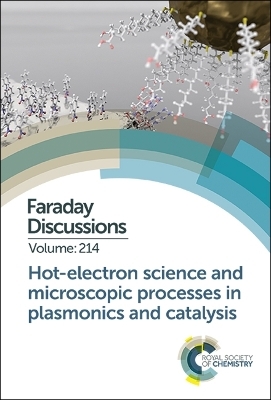
Hot-electron Science and Microscopic Processes in Plasmonics and Catalysis
Royal Society of Chemistry (Verlag)
978-1-78801-670-4 (ISBN)
Over the last 10 years, the field of plasmonic research has emerged as an extremely promising technology with several main fields of application: information technologies, energy, high-density data storage, photovoltaics, chemistry, biology, medicine and security. The main focus up to a few years ago was on the ability of plasmonic nanostructures to generate localized regions of highly concentrated electromagnetic fields, however more recently it has also been realized that the electron part of plasmonic excitations can also be exploited in the physical and chemical sciences.
Fascinating proof-of-concept applications have over the last three years been demonstrated in areas such as surface-enhanced catalysis (water splitting), photodetectors without bandgaps (Schottky junctions), and nanoscale control over chemical reactions. These applications as well as the most recent breakthroughs and key challenges in this multidisciplinary and dynamic field are the focus of this Faraday Discussion, offering the perspectives of physicists, chemists and ab-initio theoreticians.
In this volume the topics covered include:
Dynamics of hot electron generation in metallic nanostructures
Theory of hot electrons
New materials for hot electron generation
Applications in catalysis, photochemistry, and photodetection
Faraday Discussions documents a long-established series of Faraday Discussion meetings which provide a unique international forum for the exchange of views and newly acquired results in developing areas of physical chemistry, biophysical chemistry and chemical physics. The papers presented are published in the Faraday Discussion volume together with a record of the discussion contributions made at the meeting. Faraday Discussions therefore provide an important record of current international knowledge and views in the field concerned. The latest (2017) impact factor of Faraday Discussions is 3.427.
Dynamics of Hot-electron Generation in Metallic Nanostructures;
Theory of Hot-electrons;
New Materials for Hot-electron Generation;
Applications in Catalysis, Photochemistry, and Photodetection
| Erscheinungsdatum | 14.06.2019 |
|---|---|
| Reihe/Serie | Faraday Discussions ; Volume 214 |
| Mitarbeit |
Sonstige Mitarbeit: Royal Society of Chemistry |
| Verlagsort | Cambridge |
| Sprache | englisch |
| Maße | 156 x 234 mm |
| Gewicht | 895 g |
| Themenwelt | Naturwissenschaften ► Chemie ► Analytische Chemie |
| Naturwissenschaften ► Chemie ► Physikalische Chemie | |
| ISBN-10 | 1-78801-670-X / 178801670X |
| ISBN-13 | 978-1-78801-670-4 / 9781788016704 |
| Zustand | Neuware |
| Informationen gemäß Produktsicherheitsverordnung (GPSR) | |
| Haben Sie eine Frage zum Produkt? |
aus dem Bereich


